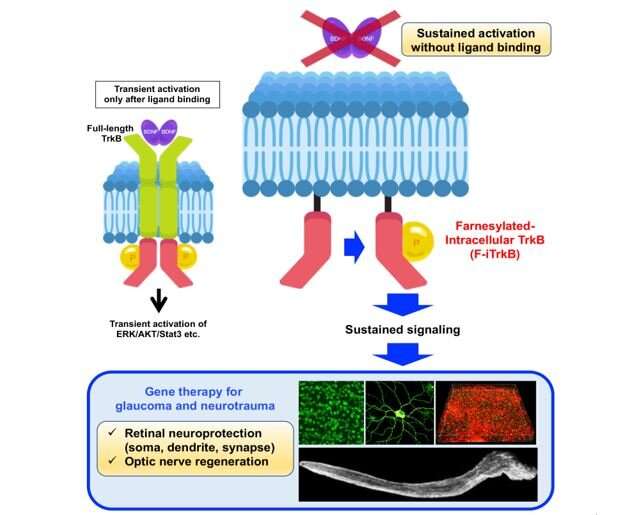Researchers stimulate neuroprotection and optic nerve regeneration in mouse models of glaucoma

Glaucoma is the leading cause of irreversible blindness due to optic nerve damage and the death of retinal ganglion cells (RGCs). Presently, reducing intraocular pressure is the sole evidence-based therapy for glaucoma patients, but this therapy is ineffective in a considerable proportion of glaucoma patients, especially those with normal tension glaucoma.
Therefore, other strategies for suppressing further degeneration of RGCs, such as neuroprotection through activation of neurotrophic factor signaling, have been investigated. For example, brain-derived neurotrophic factor (BDNF) stimulates RGC protection through its high-affinity receptor TrkB. However, the transient nature of ligand-dependent activation limits the effectiveness of this treatment.
Researchers at the Tokyo Metropolitan Institute of Medical Science and colleagues solved the problem of transient activation by inventing a system that forces membrane localization of the intracellular domain of TrkB through farnesylation (F-iTrkB). This results in constitutive TrkB activation in the absence of ligands. The small size of F-iTrkB allows it to be packaged in adeno-associated virus (AAV) and allows high expression of the transgene.
Intraocular injection of AAV-F-iTrkB significantly enhanced the survival of RGCs in both high and normal intraocular pressure mouse glaucoma models. AAV-F-iTrkB also protected RGCs and induced robust optic nerve regeneration in an optic nerve injury model. In an optic tract transection model, in which the visual pathway in the brain (superior colliculus) were damaged, intraocular injection of AAV-F-iTrkB induced axon regeneration at the injury site and restored connections to brain targets, resulting in partial recovery of visual behavior.
With further characterization and enhancement of delivery, AAV-F-iTrkB may become an effective gene therapy tool for treatment of axonal damage and some neurodegenerative diseases, including glaucoma.
The work is published in the journal Molecular Therapy.
More information: Euido Nishijima et al, Vision protection and robust axon regeneration in glaucoma models by membrane-associated Trk receptors, Molecular Therapy (2022). DOI: 10.1016/j.ymthe.2022.11.018

















